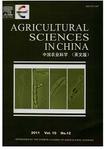Gene Mapping of Brachytic Stem and Its Effect on Main Agronomic Traits in Soybean
Gene Mapping of Brachytic Stem and Its Effect on Main Agronomic Traits in Soybean作者机构:National Center for Soybean Improvement National Key Laboratory of Crop Genetics and Germplasm Enhancement Nanjing Agricultural University Nanjing 210095 P.R.China
出 版 物:《Agricultural Sciences in China》 (中国农业科学(英文版))
年 卷 期:2005年第4卷第10期
页 面:728-732页
基 金:This work was supported by the National 973 Program(2004CB7206) National 863 Program of China(2002AA211052) Jiangsu Provincial Natural Science Foundation(BK2004045)
主 题:Brachytic stem Gene mapping Quantitative trait loci (QTL) Agronomic trait Soybean
摘 要:Brachytic stem is a major trait in plant type .of soybean and its yield potential may be higher under high population when compared with normal stem. In the present investigation, 152 recombinant inbred line (RIL) families derived from the cross of Bogao (normal stem) and Nannong 94-156 (brachytic stem) were used to map genes and QTLs of three plant type traits and to identify the effects of brachytic stem on agronomic traits such as yield. The primary results indicated that brachytic stem (sb) and determinate growth habit (drl) were mapped on linkage groups B2 and L, three major QTLs related to plant height were detected and mapped on linkage group L near drl, another minor QTL was mapped near sb on linkage group B2-1. Lines with brachytic stem had shorter plant height, lower biomass, yield, harvest index and pods per plant, and essentially no differences in days to maturity and 100-seed weight when compared with normal stem lines. It was obvious that the effect of brachytic stem on yield was due to the decreased height, biomass and harvest index.



